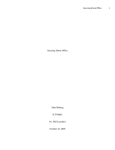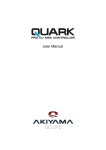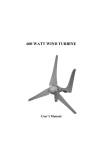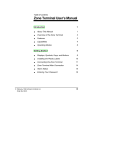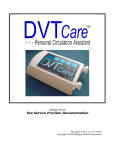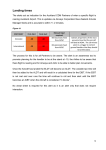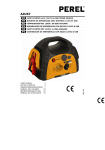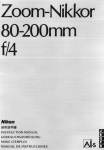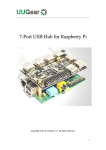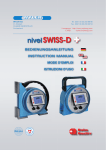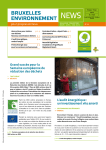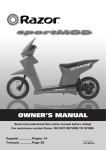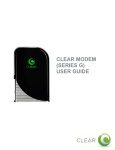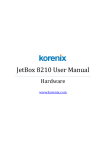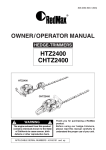Download 1500 WATT WIND TURBINE User`s Manual
Transcript
1500 WATT WIND TURBINE User’s Manual Ver.2013.3.2 TABLE OF CONTENT 1. SAFETY........................................................................................................................................................ 3 1.1 Mechanical Hazard........................................................................................................................... 4 1.2 Electrical Hazard............................................................................................................................... 4 2. MODEL AND SPECIFICATION TABLE ................................................................................................... 5 2.1 Specification Table............................................................................................................................ 5 2.2 Performance specifications ............................................................................................................. 5 3. DIGITAL-CONTROLLED MPPT WIND POWER CHARGER .............................................................. 6 3.1 System wiring diagrams .................................................................................................................. 9 3.2 Mechanical Stop Switch ................................................................................................................ 12 4. PACKAGE CONTENTS ........................................................................................................................... 13 5. INSTALLATION PROCEDURE............................................................................................................... 15 6. MAINTENANCE ........................................................................................................................................ 20 7. FAQS .......................................................................................................................................................... 20 8. WARRANTY .............................................................................................................................................. 23 APPENDIX A IMPORTANT SAFETY INSTRUCTIONS .......................................................................... 25 APPENDIX B BEAUFORT WIND SCALE ................................................................................................. 26 APPENDIX C BATTERY CONNECTION ILLUSTRATION ..................................................................... 27 APPENDIX D RECOMMENDED WIRE GAUGE ..................................................................................... 28 APPENDIX E REGISTRATION FORM ...................................................................................................... 29 2 1. SAFETY Your 1500 Watt Wind Turbine is designed with your personal safety as the first priority. However, there are still some inherent dangers involved with any electrical and/or mechanical equipment. Safety must be the primary concern as you plan the location, installation and operation of the Turbine. Please read the following: Important Safety Instructions Please take the time to read through this manual prior to assembly. 1) Place this instruction manual in a safe place for reference. 2) Wait until a calm day to install or perform maintenance on your Turbine with activation of MPPT brake or mechanical stop switch. 3) Listen to your Turbine should you hear any mechanical noise, maintenance may be required, please contact your Turbine dealer. 4) After installation re-adjust and tighten the screws and bolts. 5) Adhere to proper grounding techniques as established by the NEC. 6) Your Wind Turbine must be installed in accordance with this manual and local and national building code. Incorrect installation may void your warranty. 7) Wind Turbine blades spin at a potentially dangerous speed this must be respected. Never approach a Turbine in motion. 8) Note wire size (gauge chart included) prior to wiring. Any under sizing of wire can be potentially dangerous. 9) Check the manual brake health periodically. We suggest that the users turn on the manual brake of MPPT to see if the speed is getting low. Meanwhile, the RED LED should be illuminated once the manual brake is turned on. If you hear the sound of the relay, it means the MPPT works normally. 10) Check the three wires from the Turbine output periodically. Please use a current clamp meter to measure AC current. If the outputs are not consistent, please contact the distributor for further instruction. For safety reasons, please stop operating your Turbine. 11) Check the battery health periodically. The abnormal battery and improper connection will cause over-spin issues. The Turbine’s operation should be halted to reduce the risk of damage due to over spin of the rotor blades. 12) Operating Environment: A. Operating Temperature: -4°F (-20°C) ~ 122°F (50°C) B. Operating Humidity: < 80% C. Average Wind Speed: < 30MPH (<13 m/s or <48KMH) D. Max. Peak Wind Speed: < 45MPH (<20m/s or <70KMH) E. Elevation: < 1000m F. Applicable Installation Height: 8.85ft〜33ft (2.7m〜10m) It is subject to IEC 61400-2 safety standards. If the operating temperature and wind speed exceed the above-mentioned limits, please turn on the manual brake in proper way to shut off the Wind Turbine. 3 1.1 Mechanical Hazard Rotating blades present the most serious mechanical hazard. The rotor blades are made of very strong thermoplastic and glass fiber. At the tip, the blades may be moving at velocities over 60m/s. At this speed, the tip of a blade is nearly invisible and can cause serious injury. Under no circumstances should you install the Turbine where a person could come in contact with moving rotor blades. 1.2 Electrical Hazard The 1500W Turbine is equipped with sophisticated electronics designed to provide protection from electrical dangers. Please note that the inherent personal dangers from electrical current still exist, therefore caution should always be used when connecting this and other electrical devices. Heat in a wiring system is often a result of too much current flowing through an undersized wire or through a bad connection. Please consult wire guide table below. Batteries can deliver a dangerous amount of current. If a short circuit occurs in the wiring from the batteries, a fire can result. In order to avoid this threat, a properly sized fuse or circuit breaker is required in the lines connecting to the battery. Choosing your 1500 Watt Wind Turbine’s location Prior to the mounting of your 1500 Watt Wind Turbine, you must carefully consider a location. Things to consider when thinking about your location A) Distance from any obstacles that will cause turbulence, trees, buildings etc. z Locate your Turbine in windy sites so as not to disturb neighbors and animals around. The noise and vibration element cannot be got rid of even if 1500 Watt Wind Turbine offers the lowest noise than any others on the market. The better location of your Turbine requires avoiding personnel or animal activities within a 33 ft. (10 m) radius, and human habitation and wildlife within a 66 ft. (20 m) radius. z The minimum recommended tower height is 22 ft. (7 m) to 33 ft. (10 m). The wind speed below 22 ft. (7 m) constrained by the terrain is low and chaotic. For example: If wind in your area is more than 30 mph (13.4 m/s), the height of 7 m is recommended. The higher the Turbine stands (more than 10 m), the much stress your pole kit will sustain. Also, the Turbine possibly brakes in extreme weather conditions. z The rooftop may not be the best place for your Turbine. Here are three reasons. a. The flow is more turbulent above the rooftop and leads to the low wind power availability. b. The stress the pole kit sustains varies in rooftop constructions. The evaluation and stability cannot be guaranteed. c. The slight noise and vibration still affect sleep for some sensitive people and animals. B) Distance from MPPT controller and battery bank C) Any local zoning restrictions D) Clearance of power lines 4 2. MODEL M A AND SPE ECIFICATION TA ABLE 2.1 Specific cation Ta able Mod del 150 00W Turbine e Rela ated Speed d 14 m/s m (31.3mp ph) (45.9 ft../s) Rela ated Powerr 1500W Volttage with MPPT 24V V Roto or Diameter 1.7 m (5.58ft) Starrt-up Wind S Speed >1 m/s m Cut--in Wind Sp peed 2.5 m/s (5.59 m mph) (8.2 ft../s) Surv vival Wind S Speed 60 m/s m (134.2 m mph) (196.8 85 ft./s) Num mber of Blad des 3 Blad de Material Plas stic compou und with gla ass fiber Sug ggest Batterry Capacity >20 00 A/Hr. ※ The mecha anical stop switch shou uld be turne ed on when the wind sp peed upwarrds 40 MPH H (65 KMH). ※ Survival wind speed means m that the Wind Tu urbine will survive s 134.2 MPH wh en the mec chanical stop switch is tu urned on. Exceeding E th his stated w wind speed will w result in n Wind Turbbine failure and a collapse. 2.2 2 Perform mance sp pecificatiions The e following p power curve e shows the e performan nce you should expect from f your W Wind Turbine. During smo ooth, steadyy wind spee ed, you can expect to ssee output resembling r the curve illlustrated be elow. To con nvert betw ween power and curren nt use the fo ollowing forrmula: 5 POWER = VOLTAGE × AMPS 3. DIGITAL-CONTROLLED MPPT WIND POWER CHARGER Please see included Manual for your MPPT Charge Controller. 9 MCU fully digital-controlled MPPT wind power charger 9 Boost/Buck conversion, large DC input voltage range 9 Smart load management function, braking function MPPT Specification Table Rated Output Power 1500W Max. Battery Voltage Range 15〜35VDC (For 24VDC battery system) Input Voltage Range 5~75 Vrms Charger Efficiency 95% Max. Battery Protection Voltage 29.5±1VDC (Lead-acid batteries) 31V±1VDC (Deep cycle batteries) Rated Load Current Hi: 40A (Max.45A) / Lo: 20A (Max. 22A) Over-Speed Braking <1400 RPM 6 LED indication Light Indications Status GREEN light on Power on (working normally) Charge/Discharge GREEN light on Charging (power from Turbines) Charge/Discharge GREEN light Discharging (power from battery) flashes Protection RED light flashes Once Over-speed protection Twice High battery voltage protection Three times Over total current protection (input and output) Four times Over charging current protection Five times Overheat protection for MPPT Six times Low battery Seven times Manual brake on Eight times Overheat protection for generator Nine times Acceleration auto brake protection Remark: When the auto protections above occur, the braking will last 3 minutes before Turbines start again. Caution 1: Any under sizing of wire can be potentially dangerous; our warranty doesn’t cover damage caused by improper use of wire gauge. Caution 2: Please review the following wire gauge table to install the correct wire gauge. We recommend these as the minimum wire sizes for the distance from the MPPT and your turbine for optimal performance. Always use the largest gauge wires that are practical and affordable. Local, state, and or national electrical codes take precedence over these general recommendations. 24 Volt System, AWG / Metric Wire Size mm2 Number of 0-30 ft. Turbines: (0-9 m) 1 14/2.5 mm 2 12/4 mm 3 10/16 mm 2 2 2 30-60 ft. 60-90ft 90-150 ft. 150-190 ft. 190-250 ft. 250-310ft 310-390 ft. 390-500ft (9-18 m) (18-27 m) (27-46 m) (46-58 m) (58-76 m) (76-95 m) (95-119 m) (119-152 m) 8/10 mm 2 6/16 mm 2 4/25 mm 2 4/25 mm 2 000/90 mm 12/4 mm 2 10/6 mm 2 8/10 mm 2 6/16 mm 2 4/25 mm 2 4/25 mm 2 2/35 mm 2 2/35 mm 2 1/50 mm 2 0/50 mm 8/10 mm 2 6/16 mm 2 4/25 mm 2 2/35 mm 2 2/35 mm 2 1/50 mm 2 0/50 mm 2 00/70 mm 7 2 000/90 mm 2 2 2 System protection (see also included manual) Your MPPT charge controller, equipped with sensors inside the unit, comes with four main protection functions. Self-protection: The MPPT charge controller has a temperature sensor. Temperature of the internal circuitry is moderated by an internal fan that is activated at 45°C (110°F).When the temperature exceeds 65°C (150°F), the MPPT will apply both the fan and braking system to prevent damage. Protection for Battery: The MPPT charge controller can sense the voltage of battery and the current output/input to battery. If the parameter of voltage and current is wrong, then the braking system will be turned on. Protection for Wind Turbine: The MPPT charge controller can sense the rotation speed of Wind Turbine. If the rotation speed is over the setting value in program, the braking system will be turned on. The latest version of MPPT charger controller is also equipped the phase detector technology. If the AC output wave from generator is incorrect, that means the generator may be damaged. At that moment, the MPPT will apply the braking system and the LED lamp to warn users. Protection for No Battery Connection: When the MPPT charge controller shuts down due to the abnormal battery and improper connection; it will cause free-spin issues. At 150 RPM and above, the MPPT charge controller should apply the braking system automatically and the power from the Wind Turbine should be cut off at once. The Wind Turbine will turn on and brake repeatedly. Under safety condition, please check the battery wire and function as soon as possible. 8 3.1 System m wiring diagrams d s The ere are multiple optionss to connectt your Wind d Turbine de ependent on n your poweer requirements and available comp ponents. Sin ngle Turb bine insttallation: NOTE: Please P refer to the recoommended wire gaug ge table and d select thee appropriatte wire size for your system. NOTE: Please P apply y the Mechaanical Stop Switch simultaneous sly. Refer too the SEC. 3.2 2 for detailed d info. 9 Mu ultiple Tu urbine ins stallation n: NOT TE: Please refer to thee recommen nded wire e gauge table and selecct the appro opriate wire e size for yo our system. NOT TE: Please apply the M Mechanical Stop Switch simultan neously. Reefer to the SEC C. 3.2 for de etailed info. 10 Hy ybrid Sola ar/Wind System:: A ty ypical “hybrid” system (Photovoltai ( ic and Wind d combined) is wired as s follows. Whe enever feassible wire th he Turbine and a solar pa anels to their own set of o battery teerminals. NO OTE: Please e refer to thhe recomme ended wirre gauge table and seleect the appropriate wirre size for your y system m. NO OTE: Please e apply the Mechanica al Stop Sw witch simulta aneously. R Refer to the SE EC. 3.2 for detailed d infoo. 11 3.2 Mechanical Stop Switch The MPPT controller has an integrated battery controlled braking mechanism. This is explained in your MPPT manual. Further to this protection we have incorporated a secondary level of safety and convenience with a mechanical 3-phase AC brake. During periods of high winds (upwards of 40 mph, 17m/s) it is strongly advised to utilize your MPPT brake or your mechanical stop switch. The use of your mechanical stop switch will not affect the voltage of your battery. We strongly advise the activation of the mechanical stop switch during any maintenance of or around your Turbine. This will prevent the blades spinning and voltage to be transferred. Likewise during initial installation please activate the mechanical brake. The final step in installation of Turbine, controller, and battery should be release of this mechanical stop switch. The mechanical stop switch is pre-wired for your convenience with 10 AWG wire and battery terminal connections. The wire configuration is explained in the diagram below (fig 1). Place the corresponding wires (red, black, blue) from the mechanical stop switch into the MPPT input terminals. This should match the similar colored wires from your Turbine. Your Turbine and stop switch share input terminals on the MPPT. This provides a parallel connection. Test the connection of your mechanical stop switch at the point of initial installation. Push the brake “ON”. You should see the Turbine stop its rotation. Continue to apply this brake during the remainder of your installation. Should the Turbine continue to spin, check your terminal connections. Do not approach the Turbine without activation of this mechanical stop switch under any circumstance! Notes • It is not necessary to apply MPPT brake during activation of the mechanical stop switch. • It is strongly advised to test both mechanical and MPPT stop switch periodically. • Your mechanical stop switch is pre-wired with 10 AWG wire, this should not be altered. • The mechanical stop switch should be placed close to your MPPT in a dry ventilated environment. • For multiple Turbine applications please use one mechanical stop switch for each Wind Turbine. • This mechanical stop switch has been designed Figure 1 specifically for your Wind Turbine; it should not be incorporated into other models. 12 4. PACKAGE CONTENTS Check the parts listed with the contents of the box and make sure that you have everything needed for assembly. Caution: The edges of the blades are sharp. Please handle with care. 13 Name Quantity Turbine 1 Blade 3 MPPT Charger Controller 1 Hub 1 Vertical Tail 1 Nose Cone 1 Amp Meter 1 Brake Switch (Mechanical Stop Switch) 1 Special Sleeve (M16) 1 Hex Screw (M5XL50) 1 Hex Screw (M8XL40) 6 Hex Screw (M5XL20) 4 Set Screw (M8XL12) 4 Locking Nut (M8) 6 Spacer (M16) 1 Spacer (M8) 12 Spacer for Vertical Tail 4 Hex Key No.3 1 Hex Key No.4 1 Hex Key No.6 1 Hex Screw (M5XL50) 1 Hex Screw (M8XL40) 6 Hex Screw (M5XL20) 4 Replacement Locking Nut (M8) 6 Accessory Pack Spacer (M8) 12 Spacer (M16) 1 Spacer for Vertical Tail 4 Set Screw (M8XL12) 4 Accessory Pack 14 5. INSTALLATION PROCEDURE Step 1: Open box to ensure all parts are present, remove the hub from the box. 15 Step 2: Take out the blades from box and fasten the blades on hub with nuts. Caution: There is a blue dot on hub and blade. Please ensure the dots are installed at the same side. Caution: Make sure that all of the bolts are secured with nuts and the dots all in the correct direction. 16 Step 3: How to install the hub. Caution: Make sure the blue dots all face to the operator. Caution: Make sure the nub is secured with screws. If gaps still exist, please add a washer (in replacement accessory pack). Step 4: Take out the Wind Turbine from box and put the cables through the mast. 17 Step 5: To install the Wind Turbine to your chosen tower (not included) securely fasten the bolt by using the hex wrench. Caution: Owing to the base of the Turbine, the outside diameter of the iron pipe should be 48.3mm to 48.6mm and the wall thickness should be 1.9mm at least. Step 6: Put the sleeve inside the nose cone and fasten the nose cone to the hub. Apply pressure to the connections to ensure a secure fit. 18 Step 7: Tail Fin assembly. Use the four supplied spacers and HEX screws, to firmly connect the tail fin to the hub. Step 8: Final product diagram 19 6. MAINTENANCE Your 1500 Watt Wind Turbine has been designed to run for long periods without requiring any maintenance. Performance will be enhanced if you periodically inspect your system. Review the following simple maintenance procedures and implement every six months. Caution 1: Do not go near the Wind Turbine during operation. Caution 2: The blades are sharp. Please handle with care. • Check blades for superficial damage. Replace blades if damaged. It is important to not use blades that are damaged, as you will lose overall balance, resulting in a decrease in efficiency. Should you notice damage to the blades you must replace all 3. The blades are balanced as sets. • Check the blade bolts and the hub nut for tightness. • Check nosecone for cracks and tighten nuts. • Wipe any excess dirt build-up from the blades. • Check all electrical connections to make sure they are tight and free from corrosion. • Check the voltage of your battery bank with a Multi-meter and clean the terminals. • We suggest replacing the blades every five years for optimal performance 7. FAQS (1) How does the 1500 Watt Wind Turbine control power and RPM in high winds? Your Turbine’s operation will be halted to reduce the risk of damage due to overcharge and over spin of the rotor blades. This process of braking is handled internally through your Turbine electronics. (2) What is the maximum wind speed the 1500 Watt Wind Turbine will survive, and do need to take it down in a storm? Your Wind Turbine is designed to operate in most climatic conditions. Should you expect or experience winds of 150MPH upwards, please turn off the MPPT controller which will in turn manually apply the braking system to protect from any over spin. Once the Turbine has stopped it is possible to lay down the Tower to offer further protection. (3) How long will be the bearings or other wearing parts last? According to engineering calculations, the bearings should have a 10-year life span in 12- mph (6 m/s) average wind speed sites. Bearing life will vary from one application to another; however, you should expect at least a five-year performance in adverse conditions and 10 years in normal conditions. (4) Can the 1500 Watt Wind Turbine be connected in reverse-polarity to the battery without causing any damage? Reverse polarity will cause damage to both your MPPT controller and battery if not quickly remedied. Always double check any wiring to reduce the risk of reverse polarity. Your Turbine is equipped with 20 polarity pro otection to re educe the risk of dama age, but it is s still possib ble to degradde your wirring and cau use damage to the overall system. Reverse po olarity will ca ause the fuse inside th he MPPT da amaged. Th he fuse is deesigned to take t the currrent to prevent M MPPT and battery from m burning. T The instanta aneous pow wer surge w will possibly damage the e parts inside e MPPT. (5) Will it hurt m my 1500 Wa att Wind Tu urbine to sho ort-circuit th he output? No, the 150 00 Watt Win nd Turbine is designed to be shortt-circuited as a a normal shutdown procedure p b a by relay. The ffunction of the t stop switch is to bo oth disconne ect the Turb bine from th e batteries as well as short-circuit the outputt of the Turb bine. (6) Where can I locate tub bing to make a tower? Your 1500 W Watt Wind Turbine T is designed d to make mounting as sim mple and strraightforward as possib ble. Should you u not wish to o purchase the t custom tower kit fe eel free to uttilize scheduule 40 1.5 in nch steel tu ubing. This should d be availab ble through your local h hardware ou utlet. (7) What is the e difference between co opper and a aluminum wire? w Generally a aluminum wire w is less conductive, c so it must be b bigger fo or the samee amp load and a resistive losses as ccopper. The 1500 Watt Wind Turbi ne uses copper or tinn ned copper ffor the yaw wires. (8) What battery should I choose for my 1500 W Watt Wind Tu urbine? There are m multiple batttery options s in today’s market– flo ooded lead acid, absorb rbed Glass mat m (AGM),, gel cell and NiC Cad. There is no definitive choice for your altternative energy needss. Normally the choice of battery is determined by b availabiliity and priciing. Should you have questions q reegarding ba atteries plea ase consult a lo ocal battery supplier. Or O view: www w.batterycouncil.org. The capacityy of your battery bank is determined d by your usse. Below is s a good guiideline. • 24-volt sysstems – 200 0 Amp-hours Possible P Ba attery Config gurations (s suggested) 21 (9) Is lightning protection necessary? ? You should ground you ur 1500 Wa att Wind Turrbine. Prope er grounding g (illustratedd below) provides protection tto individuals and equip pment by e liminating th he possibilitty of dange rous voltage. Rememb ber a steel tower is a conduiit for lightnin ng. Every Wind d Turbine an nd Turbine Tower T need ds to be grounded at the tower basse even tho ough the sysstem may be gro ounded at th he battery bank. b Groun nding the tow wer at its ba ase may heelp prevent shocks s to persons tou uching the tower t due to o lightning o or electrical faults. Please take e the time to o review the e National E Electrical Co ode (NEC) and local buuilding and zoning regulations for comple ete requirem ments. Even n in “Off Grid d Systems” there are m multiple way ys for tower grounding, the most co ommon metthod is a co opper clad steel s electro ode(s) drive n into the soil. Please view v the followin ng grounding diagram. (10)) What effecct does radio interferen nce have on n my 1500 Watt W Wind Turbine? T The intern nal circuitry of the 1500 0 Watt Wind d Turbine is shielded an nd filtered too prevent ra adio interferencce, and hass been teste ed to insure e electro-ma agnetic compatibility. (11)) What effecct does my 1500 Watt Wind Turbi ne have on radio trans smissions? The 1500 Watt Wind Turbine normally doess not affect radio transm mitters. Carre should be e taken, however, tto route pow wer lines fro om the Turb bine away frrom the pow wer and anttenna lines of a radio transmitte er. An old ha am radio operator’s tricck is to twistt positive an nd negative wires togetther to provvide an even d distribution of o EMF nois se across bo oth wires, which w serves to cancel out the electrical noise e created. T This technique can be used u on the e Turbine po ower lines, on o the radioo’s power lin nes, and on n transmission wires. Transmissio T n lines shou uld always be kept as far f from pow wer lines as s is practica ally possible. P Proper grou unding of th he Turbine a and other sy ystem comp ponents mu st also be observed. o 22 (12) Will it affect the regulation of my 1500 Watt Wind Turbine to install an RF (radio frequency) filter? An RF filter should not affect the regulation of the Turbine, but any electronic devices placed in line with the Turbine must be rated for the proper current and voltage. It is best to place any line filters on the power lines for the load device that requires it, and as close to the device as possible. TROUBLE SHOOTING You may require an extra person to assist with these tests. 1) Remove the blade/hub from the Turbine. Replace the rotor hub nut on the rotor shaft. 2) Quickly spin the rotor shaft manually with your fingers while connecting and disconnecting the red and black wires (Turbine must not be connected to batteries). 3) With the red and black wires connected to each other, the shaft should be more difficult to turn. When the wires are disconnected it should spin freely. Should this not be true please contact your Turbine dealer. 4) With your 1500 Watt Wind Turbine connected to your battery bank, use an electric hand drill to spin the rotor shaft. 5) Below 150 RPM, the rotor should spin freely. 6) At 150 RPM and above, the Wind Turbine should be charging the battery. You should feel resistance on the rotor shaft if the shaft is not rotating; contact your Turbine dealer. Be aware your battery banks needs to be under 24V for this testing as the Turbine needs to read a charge. 8. WARRANTY We warrant your product to be free from defects in material and/or workmanship for a period of 1 year from original date of purchase. Warranty coverage is extended only to customer (original purchaser). If product proves defective during warranty period, the manufacturer, at its option will: 1. Replace Wind Turbine with new or refurbished product. 2. Correct reported problem Customers warranty continues to be valid on repaired or replaced product from original warranty date. Restrictions This warranty covers defects in manufacturing discovered while using the product as recommended by the manufacturer. The warranty does not apply to a) equipment, materials, or supplies not manufactured by the manufacturer. b) Product that has been modified or altered other than by the manufacturer or without prior manufacturer’s approval. c) Has been exposed to winds exceeding 134mph d) Windstorms, lightning and Hail damage e) Repairs performed by other than authorized support staff. f) All acts of God; misuse, negligence or accidents. g) Tower foundation and wire has not been installed, operated, repaired or maintained in accordance with the instructions supplied by manufacturer. Any service identified in the above list or product is found not to have any defect in manufacturers’ workmanship or materials the customer will be responsible for the costs of all repairs and expenses incurred by the manufacturer. 23 Disclaimer EXCEPT FOR THE EXPRESSED WARRANTY SET FORTH ABOVE, THE MANUFACTURER DISCLAIMS ALL OTHER EXPRESSED AND IMPLIED WARRANTIES, INCLUDING THE IMPLIED WARRANTIES OR FITNESS FOR A PARTICULAR PURPOSE, MERCHANTABILITY AND NON-INFRINGEMENT. NO OTHER WARRANTY, EXPRESSED OR IMPLIED, WHETHER OR NOT SIMILAR IN NATURE TO ANY OTHER WARRANTY PROVIDED HEREIN, SHALL EXIST WITH RESPECT TO THE PRODUCT SOLD UNDER THE PROVISIONS OF THESE TERMS AND CONDITIONS. THE MANUFACTURER EXPRESSLY DISCLAIMS ALL LIABILITY FOR BODILY INJURIES OR DEATH THAT MAY OCCUR, DIRECTLY OR INDIRECTLY, BY USE OF THE PRODUCT BY ANY PERSON. ALL OTHER WARRANTIES ARE EXPRESSLY WAIVED BY THE CUSTOMER. Warranty Claims & Return Policies To be eligible for service under this warranty, customer must either contact manufacturer either through written request or by telephone to submit a service request for the Wind Turbine covered by this warranty within specified period (1 year from original date of purchase) and request a return authorization (RA) number, This RA # must be issued before any product can be returned. All notifications must include the following information: a) Description of alleged defect b) How the Wind Turbine was being used c) Serial # d) The original purchase date e) Name, phone #, address of party requesting warranty Within 2 to 3 business days the manufacturer will provide the customer with an RA# and will direct customer to location where the product is to be returned. Once an RA has been issued the customer has 30 days to return the product. Failure to deliver the product within the 30 days results in the RA as no longer being valid and a new RA must be issued. Manufacturer is under no obligation to accept any product that is returned to them without a proper RA #. Limitation of Liability UNDER NO CIRCUMSTANCES WILL THE MANUFACTURER OR ITS AFFILIATES OR SUPPLIERS BE LIABLE OR RESPONSIBLE FOR ANY LOSS OF USE, INTERRUPTION OF BUSINESS, LOST PROFITS, LOST DATA, OR INDIRECT, SPECIAL, INCIDENTAL, OR CONSEQUENTIAL DAMAGES OF ANY KIND REGARDLESS OF THE FORM OF ACTION, WHETHER IN CONTRACT, TORT (INCLUDING NEGLIGENCE), STRICT LIABILITY OR OTHERWISE, RESULTING FROM THE DEFECT, REPAIR, REPLACEMENT, SHIPMENT OR OTHERWISE, EVEN IF THE MANUFACTURER OR ITS AFFILIATE OR SUPPLIER HAS BEEN ADVISED OF THE POSSIBILITY OF SUCH DAMAGE. 24 AP PPENDIX X A IMPORTANT SAFETY S INSTRU UCTIONS Rea ad these insstructions be elow before e installing yyour Wind Turbine T to ensure peopple and prop perty againsst accidents. Plea ase also ma ake sure it is s set up und der environmental and operating cconditions. 1. Locate your Wind Turb bine in wind dy sites so a as not to dis sturb neighb bors and annimals aroun nd. The noise on element cannot be got g rid of evven if Sunforrce Wind Tu urbine offerss the lowestt noise than n any and vibratio others on th he market. The T better location l of yyour Wind Turbine T requ uires avoidiing personn nel or anima al activities within a 33 ft (10 m) radius, and hu man habita ation and wildlife within a 66 ft (20 m) radius. 2. The height of installation should be b 22 ft (7 m m) to 33 ft (1 10 m). The wind speedd below 22 ft f (7 m) d by the terrrain is low and a chaotic . constrained For example: Iff winds in yo our area are e more than n 30 mph (13.4 m/s), th he height off 7 m is reco ommended. The high her the Wind d Turbine stands (more e than 10 m m), the much h stress you ur pole kit w will sustain. Also, the Wind W Turb bine possibly brakes in n extreme weather w con ditions. O Operating En nvironment: A A. Operating Temperature T e: -4°F (-20°C C) ~ 122°F (5 50°C) B B. Operating Humidity: < 80% 8 C C. Average Wind W Speed: < 30MPH (<113 m/s or <4 48KMH) D D. Max. Peak k Wind Speed d: < 45MPH (<20m/s or <70KMH) < E E. Elevation: < 1000m F.. Applicable Installation Height: H 8.85ftt〜33ft (2.7m m〜10m) Itt is subject to o IEC 61400--2 safety stanndards. If the e operating te emperature and a wind spe eed exceed th the above-me entioned limiits, tu urn on the ma anual brake in proper waay to shut offf the Turbine.. 3. The rooftop p may not be the best place p for yo our Wind Turbine. Here e are three rreasons. a. The flo ow is more turbulent ab bove the ro oftop and le eads to the low wind poower availa ability. b. The sttress the po ole kit sustains varies in n rooftop co onstructions s. The evaluuation and stability s cannot be gua aranteed. c. The slight noise and a vibration still affectt sleep for some s sensittive people aand animals. 4. Check the m manual brake health periodically. We sugges st that the users turn onn the manual brake of MPPT to se ee if the spe eed is gettin ng low. Mea anwhile, the e RED LED should be i lluminated once the manual bra ake is turned d on. If you hear the so ound of the relay, it me eans the MP PPT works normally. n 5. Check the tthree wires from the Wind W Turbine e output perriodically. Please use a current cla amp meter to t measure AC C current. Iff the outputs are not co onsistent, please conta act the distriibutor for further instrucction. For safety rreasons, ple ease stop operating o yo our Wind Tu urbine. 6. Check the b battery health periodically. The ab bnormal batttery and improper connnection will cause over-spin isssues. The Wind Turbin ne’s operat ion should be b halted to o reduce thee risk of dam mage due to o over spin of the rotor blades. b 7. Survival win nd speed means m that the t wind turrbine will survive 157 MPH M (250 K KMH) when the manual brake is turrned on. Exceeding this s stated win nd speed will result in wind w turbinee failure and d collapse. 25 AP PPENDIX X B BEAU UFORT WIND W SCA ALE Avg. Wind W Av vg. Wind Spee ed S Speed (knot//h) ((km/h) Calm <1 1 L Light air 2 3 Bea aufort escription De No. N Calm 0 4 Avg. Wind d Avg.. Wind Speed (m/s) Speed d (mi/h) <2 < 0.55 < 11.24 1-3 2-6 0.55~1.66 6 1.244~3.73 Lig ght breeze 4-6 7 - 12 1.95~3.33 3 4.355~7.46 Gen ntle breeze 7 - 10 1 13 - 19 3.61~5.27 7 8.08~ ~11.81 11 - 16 1 2 20 - 30 5.55~8.33 3 12.433~18.64 M Moderate breeze 5 Fre esh breeze 17 - 21 2 3 31 - 40 8.61~11.11 19.266~24.85 6 Stro ong breeze 22 - 27 2 4 41 - 51 11.38~14.1 16 25.488~31.69 7 Mod derate gale 28 - 33 3 5 52 – 62 14.45~17.2 22 32.31 ~38.53 8 Frresh gale 34 - 40 4 6 63 – 75 17.5~20.8 83 39.155~46.60 9 Strong gale 41 - 47 4 7 76 – 87 21.11~24.1 16 47.222~54.06 10 1 Storm 48 - 55 5 88 8 – 103 24.44~28.6 61 54.688~64.00 11 1 Vio olent storm 56 - 63 6 10 04 – 117 28.88~32.5 64.622~72.70 12 1 H Hurricane ≥ 64 4 ≥ 118 > 32.77 > 773.32 Image *It is s strongly a advised to manually m turrn on your M Mechanical Stop Switch h during perriods of high winds (upw wards of Be eaufort Wind d Scale 7). Please refe er to Append dix A for dettailed inform mation. 26 APPENDIX C BATTERY CONNECTION ILLUSTRATION Caution: Always connect to the correct port (Figure-1). Double checks before you activate your system. Improper connections (Figure-2) can cause failure of output and the protection function may not work. 27 APPENDIX D RECOMMENDED WIRE GAUGE To determine the wire size, measure the distance from the MPPT to your turbine. Be sure to include height of the tower. A. Distance : 0-30 ft (0-9 m) System Voltage AWG/Metric Wire Size (mm2) 24V 14/2.5 mm2 B. Distance: 30-60 ft (9-18 m) System Voltage AWG/Metric Wire Size (mm2) 24V 12/4 mm2 C. Distance: 60-90 ft (18-27 m) System Voltage AWG/Metric Wire Size (mm2) 24V 10/6 mm2 NOTE: Please refer to the recommended wire gauge table and select the appropriate wire size for your system. 28 APPENDIX E REGISTRATION FORM Registration Form RA No.:____________________ Serial No.: Date: Event Date: Location: Please fill out the following questions for further investigation. 1. The wire used between the wind turbine and the MPPT: _______ AWG or metric wire size _______mm2 2. The interval between the wind turbine and the MPPT: __________ ft or __________ m 3. The battery capacity: __________ A/Hr 4. The interval between the MPPT and the battery: __________ ft or __________ m Photo (If applicable) 29































